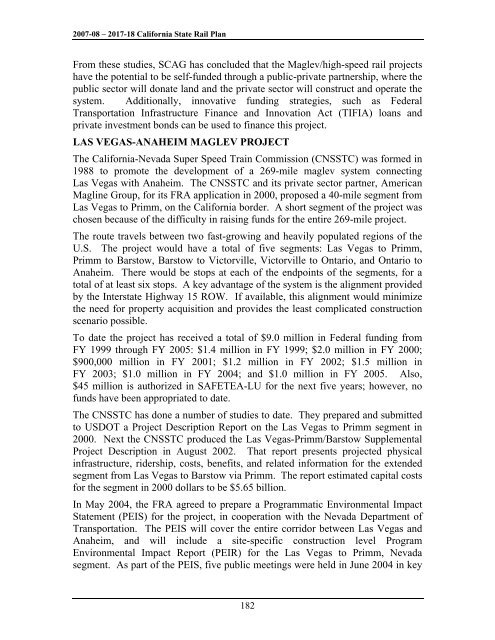California State Rail Plan 2007-08 to 2017-18
California State Rail Plan 2007-08 to 2017-18
California State Rail Plan 2007-08 to 2017-18
- No tags were found...
Create successful ePaper yourself
Turn your PDF publications into a flip-book with our unique Google optimized e-Paper software.
<strong>2007</strong>-<strong>08</strong> – <strong>2017</strong>-<strong>18</strong> <strong>California</strong> <strong>State</strong> <strong>Rail</strong> <strong>Plan</strong>From these studies, SCAG has concluded that the Maglev/high-speed rail projectshave the potential <strong>to</strong> be self-funded through a public-private partnership, where thepublic sec<strong>to</strong>r will donate land and the private sec<strong>to</strong>r will construct and operate thesystem. Additionally, innovative funding strategies, such as FederalTransportation Infrastructure Finance and Innovation Act (TIFIA) loans andprivate investment bonds can be used <strong>to</strong> finance this project.LAS VEGAS-ANAHEIM MAGLEV PROJECTThe <strong>California</strong>-Nevada Super Speed Train Commission (CNSSTC) was formed in1988 <strong>to</strong> promote the development of a 269-mile maglev system connectingLas Vegas with Anaheim. The CNSSTC and its private sec<strong>to</strong>r partner, AmericanMagline Group, for its FRA application in 2000, proposed a 40-mile segment fromLas Vegas <strong>to</strong> Primm, on the <strong>California</strong> border. A short segment of the project waschosen because of the difficulty in raising funds for the entire 269-mile project.The route travels between two fast-growing and heavily populated regions of theU.S. The project would have a <strong>to</strong>tal of five segments: Las Vegas <strong>to</strong> Primm,Primm <strong>to</strong> Bars<strong>to</strong>w, Bars<strong>to</strong>w <strong>to</strong> Vic<strong>to</strong>rville, Vic<strong>to</strong>rville <strong>to</strong> Ontario, and Ontario <strong>to</strong>Anaheim. There would be s<strong>to</strong>ps at each of the endpoints of the segments, for a<strong>to</strong>tal of at least six s<strong>to</strong>ps. A key advantage of the system is the alignment providedby the Interstate Highway 15 ROW. If available, this alignment would minimizethe need for property acquisition and provides the least complicated constructionscenario possible.To date the project has received a <strong>to</strong>tal of $9.0 million in Federal funding fromFY 1999 through FY 2005: $1.4 million in FY 1999; $2.0 million in FY 2000;$900,000 million in FY 2001; $1.2 million in FY 2002; $1.5 million inFY 2003; $1.0 million in FY 2004; and $1.0 million in FY 2005. Also,$45 million is authorized in SAFETEA-LU for the next five years; however, nofunds have been appropriated <strong>to</strong> date.The CNSSTC has done a number of studies <strong>to</strong> date. They prepared and submitted<strong>to</strong> USDOT a Project Description Report on the Las Vegas <strong>to</strong> Primm segment in2000. Next the CNSSTC produced the Las Vegas-Primm/Bars<strong>to</strong>w SupplementalProject Description in August 2002. That report presents projected physicalinfrastructure, ridership, costs, benefits, and related information for the extendedsegment from Las Vegas <strong>to</strong> Bars<strong>to</strong>w via Primm. The report estimated capital costsfor the segment in 2000 dollars <strong>to</strong> be $5.65 billion.In May 2004, the FRA agreed <strong>to</strong> prepare a Programmatic Environmental Impact<strong>State</strong>ment (PEIS) for the project, in cooperation with the Nevada Department ofTransportation. The PEIS will cover the entire corridor between Las Vegas andAnaheim, and will include a site-specific construction level ProgramEnvironmental Impact Report (PEIR) for the Las Vegas <strong>to</strong> Primm, Nevadasegment. As part of the PEIS, five public meetings were held in June 2004 in key<strong>18</strong>2













